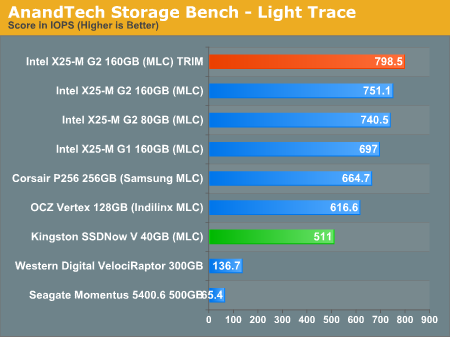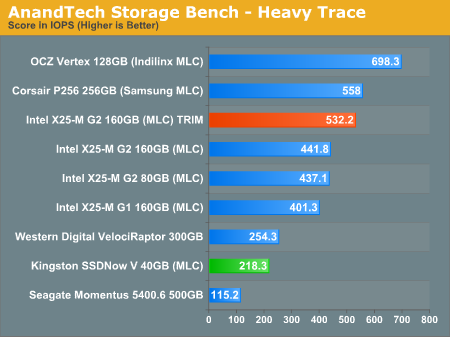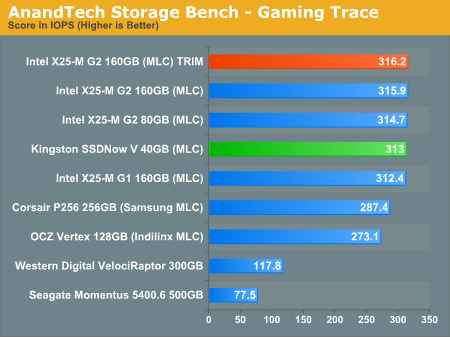The SSD Improv: Intel & Indilinx get TRIM, Kingston Brings Intel Down to $115
by Anand Lal Shimpi on November 17, 2009 7:00 PM EST- Posted in
- Storage
Introducing the AnandTech Storage Bench - Real World Performance Testing
Finding good, real world, storage benchmarks is next to impossible. The synthetic tests work up to a certain point but you need real world examples. Measuring performance in individual applications often ends up with charts like these where all of the drives perform identically. Benchmark suites like PCMark Vantage are the best we can do, but they are a bit too easy on these drives in my opinion and while representative of a real world environment, they aren’t necessarily representative of all real world environments.
Recently we’ve been able to get our hands on a piece of software that allows us to record all disk activity on a machine and then play it back on any other machine. The point is that we can now model a real world usage scenario without waiting for BAPCo or Futuremark to do it for us.
Our benchmarks debut here, today, and we’re starting with three. We haven’t had time to run all of the SSDs through this new suite so we’ll start with an abridged list.
The first in our new benchmark suite is a light usage case. The Windows 7 system is loaded with Firefox, Office 2007 and Adobe Reader among other applications. With Firefox we browse web pages like Facebook, AnandTech, Digg and other sites. Outlook is also running and we use it to check emails, create and send a message with a PDF attachment. Adobe Reader is used to view some PDFs. Excel 2007 is used to create a spreadsheet, graphs and save the document. The same goes for Word 2007. We open and step through a presentation in PowerPoint 2007 received as an email attachment before saving it to the desktop. Finally we watch a bit of a Firefly episode in Windows Media Player 11.
There’s some level of multitasking going on here but it’s not unreasonable by any means. Generally the application tasks proceed linearly, with the exception of things like web browsing which may happen in between one of the other tasks.
The recording is played back on all of our drives here today. Remember that we’re isolating disk performance, all we’re doing is playing back every single disk access that happened in that ~5 minute period of usage. The light trace is composed of 37,501 reads and 20,268 writes. Over 30% of the IOs are 4KB, 11% are 16KB, 22% are 32KB and approximately 13% are 64KB in size. Less than 30% of the operations are absolutely sequential in nature. Average queue depth is 6.09 IOs.
The performance results are reported in I/O Operations per Second (IOPS):

The hard drives set the minimum level of expectations here, the VelociRaptor only manages 137 IOPS. The fastest SSD is the X25-M G2 with the TRIM firmware installed at nearly 800 IOPS. The improvement over the older firmware is 6.25% thanks to the higher sequential write speed. The G2 is a bit faster than the G1 here, but what’s most interesting is how well the competing SSDs do.
Corsair’s P256 based on the Samsung RBX controller is very close to the performance of Intel’s X25-M G1 at 664 IOPS. It even outperforms the Indilinx MLC based OCZ Vertex by around 8%.
The Kingston 40GB drive is hampered by its small amount of free space. The actual benchmark takes up around 33GB of space, leaving very little breathing room for the baby SSD. That being said, the hopefully $85 bugger is nearly 4x the speed of a VelociRaptor.
If there’s a light usage case there’s bound to be a heavy one. In this test we have Microsoft Security Essentials running in the background with real time virus scanning enabled. We also perform a quick scan in the middle of the test. Firefox, Outlook, Excel, Word and Powerpoint are all used the same as they were in the light test. We add Photoshop CS4 to the mix, opening a bunch of 12MP images, editing them, then saving them as highly compressed JPGs for web publishing. Windows 7’s picture viewer is used to view a bunch of pictures on the hard drive. We use 7-zip to create and extract .7z archives. Downloading is also prominently featured in our heavy test; we download large files from the Internet during portions of the benchmark, as well as use uTorrent to grab a couple of torrents. Some of the applications in use are installed during the benchmark, Windows updates are also installed. Towards the end of the test we launch World of Warcraft, play for a few minutes, then delete the folder. This test also takes into account all of the disk accesses that happen while the OS is booting.
The benchmark is 22 minutes long and it consists of 128,895 read operations and 72,411 write operations. Roughly 44% of all IOs were sequential. Approximately 30% of all accesses were 4KB in size, 12% were 16KB in size, 14% were 32KB and 20% were 64KB. Average queue depth was 3.59.

While I appreciate that Intel improved sequential write speed a bit in the 160GB G2 drives, the heavy trace results show us that it’s not enough. The improvement to the 160GB G2 is tremendous, over 20%. But that only brings the 160GB G2 up to the performance of the Corsair P256 (Samsung RBX). The real winner here is the Indilinx based OCZ Vertex. At nearly 700 IOPS it has the right balance of random and sequential read/write speed for our heavy usage scenario. To quote from the Relapse:
“When I started writing this article I took a big step. I felt that Indilinx drives had reached the point that their performance was good enough to be considered an Intel alternative. I backed up my X25-M, pulled it out, and swapped in an OCZ Vertex drive - into my personal work system. I've been using it ever since and I must admit, I am happy. Indilinx has done it, these drives are fast, reliable (provided that you don't upgrade to the latest firmware without waiting a while) and are good enough.”
This is more than good enough, this is faster than Intel.
Unfortunately Intel has assured me that there’s no additional write speed left on the table for the X25-M G2. We’ll have to wait for the G3 next year to see that addressed.
Kingston’s very low sequential write speed hurts it the most here, the drive actually delivers performance lower than that of a VelociRaptor (although not by much). To be honest, this is a bit of an unfair test for the 40GB drive. It’s far too intense for what would ultimately be an apps/OS drive, but it does highlight the 40GB drive's weakpoints.
Our final test focuses on actual gameplay in four 3D games: World of Warcraft, Batman: Arkham Asylum, FarCry 2 and Risen, in that order. The games are launched and played, altogether for a total of just under 30 minutes. The benchmark measures game load time, level load time, disk accesses from save games and normal data streaming during gameplay.
The gaming trace is made up of 75,206 read operations and only 4,592 write operations. Only 20% of the accesses are 4KB in size, nearly 40% are 64KB and 20% are 32KB. A whopping 69% of the IOs are sequential, meaning this is predominantly a sequential read benchmark. The average queue depth is 7.76 IOs.

The gaming test is almost entirely reads and thus the Intel drives have no weaknesses. The G2s, G1s, TRIM or not, all perform about the same here. They’re about 10% faster than Samsung and 15% faster than Indilinx. Even the 40GB Kingston does just as well here.










162 Comments
View All Comments
mbreitba - Tuesday, October 27, 2009 - link
Looks like a lot of people are having problems with it, and Intel has pulled it :http://communities.intel.com/thread/7693?start=45&...">http://communities.intel.com/thread/7693?start=45&...
Griswold - Wednesday, October 28, 2009 - link
If you actually look at the number of people with the issue and filter out the chit-chat, its not "alot" actually. However, my flash went just fine.Thats the risk with flashing firmware regardless of what device it is. Theres always the chance to brick it. Thats also why I dont understand why some people flash every fucking piece of hardware whenever theres a new firmware available - ok, this is a different case, here it makes perfectly sense.
strikeback03 - Wednesday, October 28, 2009 - link
Has anyone had problems flashing a drive before they put any data on it? I have a new G2 still in the box that I just haven't yet had time to do anything with, was planning on flashing it then loading Win7 and Ubuntu 9.10 this weekend, have there been any reports of issues when loading an OS after flashing?UltraWide - Tuesday, October 27, 2009 - link
Great article, I like the definite conclusions and recommendations. Keep up the good work!nicolasv - Tuesday, October 27, 2009 - link
Hi AnandIn 'The SSD Relapse' you state that the G2 "doesn't drop in performance when used...at all." Yet in 'The SSD Improv' the 80GB G2 with TRIM firmware drops more than 60% in the 4KB random write test.
Granted, the charts and figures used in 'Relapse' to back its claim are for the 160GB G2 and these results are for the 80GB G2. What do you attribute this difference in performance to, the new TRIM firmware?
As a Mac OS X user, at this point, I feel like I can only really consider drives that perform well without TRIM, especially in the <= 80GB range, so would appreciate your feedback.
Cheers
Nicolas
7Enigma - Tuesday, October 27, 2009 - link
I believe it is because in that particular test he is writing to the ENTIRE 80gig drive, so it's not that TRIM isn't working per se, rather that there is no free space to allow TRIM to do anything at all.7Enigma - Tuesday, October 27, 2009 - link
As an addendum to my previous post, you can see that after file deletion the performance goes back to virtually new. So in a sense the performance of the drive never goes down, UNLESS you simply delete a partition rather than erasing the data on that partition FIRST and then deleting it.I think that's probably something that needs to be implemented with an updated driver, or at least a warning box that comes up saying "deleting this partition without formatting will hinder performance".
GullLars - Tuesday, October 27, 2009 - link
I don't know if you have done extensive benchmarking with SSDs, but using IO QD = 3 for 4KB random in IOmeter don't yield representative results for intels SSDs. I have been benchmarking SSDs with some other guys for over a year now, and we have found that while Samsung and Indilinx scale from QD 1-4 and then flat out, Intels x25-M scales well all the way to around QD 10-16, and actually is capable of over 140 MB/s at 4KB random read at QD=64 in fresh state, and still over double your messured 60-64 MB/s in used state.In our benchmark thread, the records with x25-M from ICH10R before TRIM firmware are:
IOmeter
4KB random read QD=64: 40913 IOPS = 163,5 MB/s
4KB random write QD=64: 19360 IOPS = 77 MB/s
PCmark vantage HDD score: 43107.
The same guy that got the random read and PCmark scores above also got PCmark vantage HDD score 120374 with 3 x25-M gen1 from ICH10R.
In other words, the results posted for x25-M in this review are either in "used state" or below par.
Voo - Tuesday, October 27, 2009 - link
You know Anand trys to simulate REAL situations and a QD of 10-16 is absolutly unrealistic for a home user - don't even talk about a QD of 64. Maybe the Intel SSDs shine there, but it's just of no interest.GullLars - Tuesday, October 27, 2009 - link
In his traced "light" benchmark with mostly single-tasking the average queue depth is 6.09. If you take into account that most of the sequential read and write operations (although they are under 30%) don't generate a queue, and that 4-16KB IOs often come in bursts with more queue depth, you can easily get a QD of more than 10 with relatively mild multitasking if it involves disk access. A harddisk's cache is regulary used as a buffer for the write portion of these, but if the cache is full your system almost freezes because of the harddisks low IOPS. An example would be if you try installing windows updates or a program while running a virus scan and listening to music or extracting a compressed archive, you will quickly notice if you try this on a harddisk.